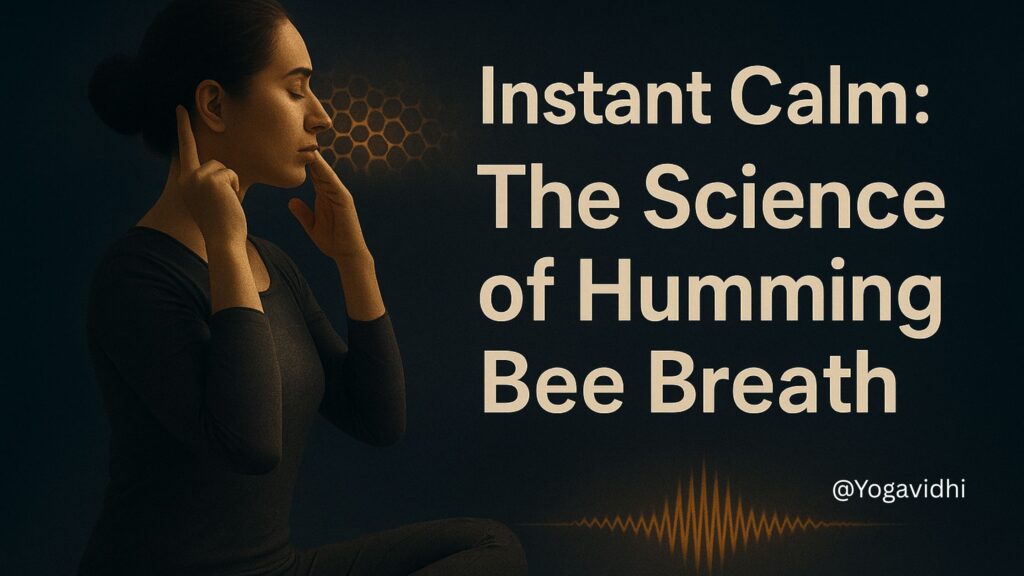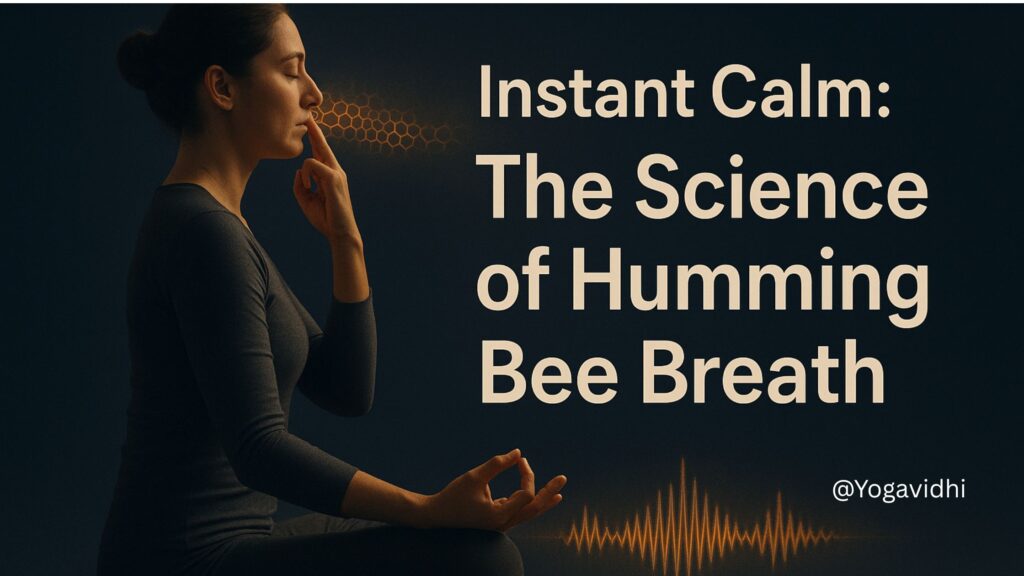In today’s fast-paced world, stress, anxiety, and restless thoughts have become part of daily life. While modern medicine provides temporary solutions, ancient yogic practices offer powerful natural remedies that bring balance to the body, mind, and spirit. One such practice is Bhramari Pranayama, also known as the Humming Bee Breath.
Bhramari Pranayama is a simple yet profound breathing exercise in yoga that uses a gentle humming sound during exhalation. This sound vibration creates a calming effect on the mind and nervous system, making it one of the most effective techniques for instant stress relief and mental clarity. Let’s explore the meaning, steps, benefits, precautions, and the science behind Bhramari Pranayama in detail.
Bhramari Pranayama, also called the Humming Bee Breath, is a yogic breathing technique in which a steady, deep humming sound—resembling a bee’s buzz—is produced during exhalation. This practice is highly effective for calming the mind, easing stress, anxiety, and anger by relaxing the nervous system. Simple and easy to do anywhere, it also serves as an excellent preparation for meditation, as it enhances focus and encourages a state of deep relaxation.
Table of Contents
What is Bhramari Pranayama?
The word Bhramari comes from the Sanskrit word Bhramar, meaning “bee.” In this practice, the practitioner makes a humming sound while exhaling, similar to the buzzing of a bee. Hence, it is called the Humming Bee Breath.
Unlike other breathing techniques that focus on speed or breath retention, Bhramari Pranayama emphasizes sound vibrations. These vibrations resonate in the head, calm the mind, and promote a meditative state.
It is often considered part of Nada Yoga (the yoga of sound), as the humming sound acts as a form of internal sound therapy. This makes Bhramari Pranayama especially useful for reducing stress, balancing emotions, and promoting inner harmony.
How to Do Bhramari Pranayama (Step-by-Step Guide)
Practicing Bhramari Pranayama is simple and can be done by anyone with proper guidance. Follow these steps to experience its calming effects:
Bhramari Pranayama Steps
- Sit in a Comfortable Position
Sit in Padmasana, Sukhasana, or any comfortable cross-legged posture. Keep your spine straight and shoulders relaxed. - Close Your Eyes and Relax
Take a few deep breaths to settle your mind and body.
3. Use Shanmukhi Mudra (Ear Closing Gesture)
- Place your index fingers gently on your ears to block external noise.
- Alternatively, use your thumbs to close your ears while resting your other fingers lightly on your forehead and around the eyes.
- Inhale Deeply
Take a slow, deep breath in through your nose, filling your lungs completely. - Exhale with a Humming Sound
As you exhale, produce a gentle humming sound (like the buzzing of a bee). Feel the vibration in your head and chest. - Repeat
Practice 5–10 rounds. Beginners can start with 5 minutes daily and gradually increase.
Best Time to Practice
- Early morning or before bedtime for relaxation
- After yoga asanas but before meditation
- In a quiet, peaceful environment
Benefits of Bhramari Pranayama
One of the reasons why Bhramari Pranayama has gained popularity worldwide is its wide range of mental, physical, and emotional benefits.
1. Mental Health Benefits
- Instantly calms the mind and relieves stress
- Reduces anxiety, depression, and negative thoughts
- Improves concentration and memory power
- Enhances creativity and mental clarity
- Helps overcome insomnia and promotes better sleep
2. Physical Health Benefits
- Lowers high blood pressure naturally
- Improves blood circulation and oxygen supply
- Strengthens the lungs and respiratory system
- Relieves sinus congestion and migraines
- Stimulates the endocrine system for hormonal balance
3. Spiritual & Emotional Benefits
- Balances emotions and promotes inner harmony
- Helps enter a meditative state effortlessly
- Awakens self-awareness and mindfulness
- Aligns mind-body connection for inner peace
In short, the benefits of Bhramari Pranayama make it one of the most effective breathing techniques for modern stress-related problems.
Read More: Kapalabhati Pranayama – The Skull-Shining Breath for Detox, Energy & Clarity
Read More: Bhastrika Pranayama: The Breath of Fire for Energy, Health & Mind Clarity
| Category | Details |
| Meaning | Bhramari = “Bee” (in Sanskrit). The practice involves humming like a bee during exhalation. |
| Other Name | Humming Bee Breath |
| Steps | 1. Sit comfortably with spine straight 2. Close eyes & relax 3. Block ears (Shanmukhi Mudra) 4. Inhale deeply 5. Exhale with humming sound 6. Repeat 5–10 rounds |
| Best Time to Practice | Early morning or before bedtime, on an empty stomach |
| Mental Benefits | Reduces stress, anxiety & depression Improves focus & memory Promotes better sleep |
| Physical Benefits | Lowers blood pressure Improves lung function Relieves migraines & sinus congestion |
| Spiritual Benefits | Enhances mindfulness Balances emotions Promotes inner peace |
| Scientific Effects | Stimulates vagus nerve Increases alpha brain waves Boosts nitric oxide production |
| Precautions | Avoid with ear infections, epilepsy, very high BP Pregnant women should practice gently |
| Duration | 5–10 minutes daily (start small & increase gradually) |
Scientific Perspective on Bhramari Pranayama
Modern research supports the traditional claims of yoga regarding Bhramari Pranayama benefits.
- The humming sound creates vibrations in the skull, which stimulate the vagus nerve. This activates the parasympathetic nervous system, responsible for relaxation and calmness.
- Studies have shown that Bhramari lowers heart rate and blood pressure, making it a natural therapy for hypertension.
- EEG scans reveal that the humming sound promotes alpha brain waves, associated with relaxation and meditation.
- The practice increases nitric oxide production in the nasal cavity, which improves immunity and supports cardiovascular health.
Thus, the science behind Bhramari Pranayama confirms why this ancient practice is so effective in reducing stress and improving overall health.
Precautions & Contraindications
Although Bhramari Pranayama is safe for most people, certain precautions must be followed:
- Avoid practicing if you have severe ear infections or recent ear surgery
- People with extremely high blood pressure should consult a doctor before practicing
- Epileptic patients should avoid or practice under expert guidance
- Pregnant women should avoid forceful humming and instead do a gentler version
- Always practice on an empty stomach and in a quiet place
By following these Bhramari Pranayama precautions, you can ensure a safe and beneficial practice.
Tips for Beginners
If you are new to yoga or pranayama, here are some helpful tips for starting Bhramari Pranayama:
- Begin with just 5 rounds daily and increase gradually
- Practice in a peaceful space with minimal distractions
- Keep the humming sound soft and steady, not loud or forced
- Combine Bhramari with meditation for deeper relaxation
- Stay consistent—daily practice gives maximum results
Common Mistakes to Avoid
To gain the full benefits of Bhramari Pranayama, avoid these common mistakes:
- Forcing the humming sound instead of keeping it gentle
- Holding the breath unnaturally or straining the throat
- Practicing on a full stomach
- Inconsistent or irregular practice
Correct practice ensures the healing vibrations reach your mind and body effectively.
Daily Routine with Bhramari Pranayama
To integrate Bhramari Pranayama into your lifestyle:
- Practice 5–10 minutes daily, preferably in the morning or evening
- Follow yoga asanas → pranayama → meditation sequence
- Use it as a quick relaxation tool during stressful moments
Many practitioners find that even 2–3 minutes of Bhramari Pranayama during a busy day can instantly calm the mind.

Conclusion
Bhramari Pranayama is a gift from the ancient yogic tradition, offering instant calmness, better mental health, and improved physical well-being. In just a few minutes of daily practice, you can reduce stress, sharpen your mind, and experience a deep sense of inner peace.
In a world full of noise, the gentle humming of Bhramari teaches us to turn inward and connect with our true self. Whether you are a beginner or an advanced yoga practitioner, this simple yet powerful pranayama can transform your life.
So, close your eyes, take a deep breath, and let the humming bee sound guide you into serenity.
FAQ:
Q. What is Bhramari Pranayama?
Ans: Bhramari Pranayama, also called the Humming Bee Breath, is a yogic breathing technique where a humming sound is made during exhalation to calm the mind and reduce stress.
Q. What are the benefits of Bhramari Pranayama?
Ans: The main benefits of Bhramari Pranayama include stress relief, better sleep, improved concentration, reduced blood pressure, and relief from anxiety, migraines, and sinus issues.
Q. How to do Bhramari Pranayama step by step?
Ans: Sit comfortably, close your eyes, block your ears with fingers, inhale deeply, and exhale slowly while producing a humming bee sound. Repeat 5–10 rounds daily.
Q. Who should not do Bhramari Pranayama?
Ans: People with severe ear infections, epilepsy, extremely high blood pressure, or pregnant women (without guidance) should avoid Bhramari Pranayama.
Q. What is the best time to practice Bhramari Pranayama?
Ans: The best time to practice Bhramari Pranayama is early morning on an empty stomach or before bedtime for relaxation and better sleep.
Q. Which mudra is used in Bhramari Pranayama?
Ans: In Bhramari Pranayama, the main mudra practiced is Shanmukhi Mudra (Six-Gate Seal) or a slight variation of it. This gesture involves closing off the senses of sight, sound, touch, smell, and taste to deepen inner focus and amplify the effect of the humming vibration. The thumbs gently close the ears, the fingers cover the eyes and nose, while the remaining fingers softly close the lips or rest around the mouth and nose, helping the practitioner turn awareness inward.
Q. How many minutes should we do Bhramari Pranayama?
Ans: Bhramari Pranayama, also known as bee breath, is usually practiced for a few minutes, with 5–10 rounds being commonly suggested. In each round, you inhale and exhale while creating a humming sound, typically lasting around 15 seconds per breath. Beginners may begin with shorter sessions and gradually extend the duration as they build comfort with the practice.
Q. What is the meaning of Bhramari?
Ans: Bhramari Pranayama, also known as “Bee Breath,” is a yogic breathing practice. The term “Bhramari” comes from the Sanskrit word Bhramara, which means “black bee.” In this technique, a gentle humming sound is created during exhalation, resembling the buzz of a bee—hence the name.
Declaration Note:
We use third-party videos and images on https://yogavidhi.com/ for educational and illustrative purposes. All rights belong to their respective owners. No copyright infringement is intended.



